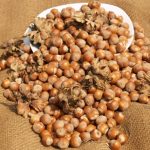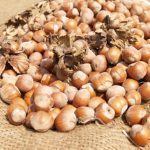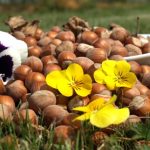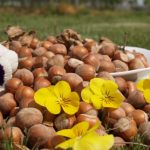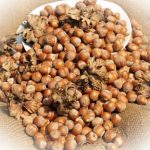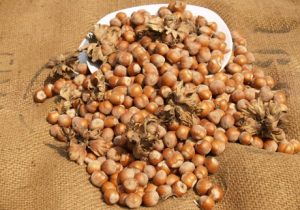
Name
Hazelnut
Seal of quality
Protected Geographical Indication (PGI) – D.M. 02/12/1993.
Description
The name Nocciola del Piemonte or Nocciola Piemonte denotes the fruit of the Tonda Gentile hazelnut of the Langa area, cultivated in the region individuated in the decree of reference within the Regione Piemonte. The Rotonda Gentile variety of the Langa area is characterised by a very hard and completely full shell, which means a 40 – 50% yield after shelling. The Nocciola Piemonte I.G.P. is particularly appreciated by the confectionery industry for its quality characteristics such as the spheroidal shape of its seed, flavour and excellent fragrance on toasting, excellent shelling, good storing capacity. It is for these reasons that the Nocciola Piemonte is universally known as being the best in the world.
The final product is represented by shelled hazelnuts and confectionery products such as gianduja, hazelnut cake, hazelnut cream, nougat, in which the hazelnut is the basic ingredient and expresses its utmost characteristics.
Nutritional characteristics
Apart from its high content of essential aminoacids and vitamin E, the hazelnut is particularly rich in lipids, with a caloric content corresponding to 700 Kcal per 100 g of dried hazelnuts. Furthermore, its lipoid fraction consists of over 40% of monounsaturated fatty acids (such as oleic acid) and offers the highest monounsaturated/polyunsaturated ratio compared with other dried fruit.
Recent studies seem to demonstrate that, if eaten regularly, hazelnuts have a positive effect on human health. In fact, it has been confirmed that a diet rich in oleic acid (the same fatty acid present in extra virgin olive oil) helps to maintain low “Bad cholesterol” level in the blood, and increases the “good cholesterol” level and, with its protective properties on cell membranes, forms an important defence factor protecting from vascular diseases. Moreover, thanks to its high tocopherol content, which includes vitamin E, the hazelnut supplies a significant quantity of antioxidant agents, thus slowing down tissue ageing.
| FOOD | unit of measurement | Nocciole secche |
|---|---|---|
| Edible part | % | 42 |
| Water | g | 4,5 |
| Protein | g | 13,8 |
| Fat | g | 64,1 |
| Carbohydrates | g | 6,1 |
| Starch | g | 1,8 |
| Soluble sugar | g | 4,1 |
| Total fibre | g | 8,1 |
| Energy | kcal | 655 |
| Kilojoules | kJ | 2740 |
| Sodium | mg | 11 |
| Potassium | mg | 466 |
| Iron | mg | 3,3 |
| Calcium | mg | 150 |
| Phosphor | mg | 322 |
| Thiamine | mg | 0,51 |
| Riboflavin | mg | 0,1 |
| Niacin | mg | 2,8 |
| Vit A ret. eq. | mcg | 30 |
| Vit C | mg | 4 |
| Vit E | mg | 15 |
Area of Production
The province of Cuneo holds the record in Piedmont of hazelnut-cultivated areas, the hazelnut being the main cultivation: with approx. 7,000 ha covering almost 89.5% of regional land intended for the planting of the Corilo species and supplies almost 85% of the Piedmontese production.
In conformity with the disciplinary regulations, the Piemonte IGP hazelnut can be produced throughout the province of Cuneo, with the exception of certain mountain areas and certain low tableland communes. The dominating area is the Langa, especially Alta Langa where the main cultivation is.
The Nocciola Piemonte IGP can also be grown in the other provinces of the region and precisely vast areas of the provinces of Alessandria, Asti and Turin and in other communes of the provinces of Biella, Novara and Vercelli.
History
Merit for having experimented hazelnut-grove planting goes to the Honourable Prof. Emanuele Férraris, born in Garessio, but “Langarolo” by election, who introduced and spread this activity to the Alta Langa district, demonstrating higher productivity of the plant and its resistance to parasitic diseases compared with vines. In fact, before then, almost every farmer had concentrated on vine-growing, in specialised or mixed cultivation, and even after the great vine louse and peronosporic blight of 1879-81 that destroyed everything, their only thought was to start from scratch. Today the vines, hardly suitable in this area, have practically been abandoned. The 20 th century marked a strong expansion of the cultivation, thanks to the high demand of the confectionery industry. Thus the Langhe, the province of Cuneo and, subsequently, the neighbouring provinces of Asti and Alessandria , became fertile land on which to plant the hazelnut, although this agricultural activity in this vast area has practically concentrated on one variety only, the “Tonda Gentile delle Langhe” which has been selected thanks to a gradual natural process guided by man.
The history of this cultivation has gone hand in hand with the evolution of the confectionery industry and with the discovery of the gianduja (a mix of chocolate and hazelnut). Credit for its creation belongs to Turinese confectioners who, due to the economic ban on confectionery products from Britain and its colonies ordered by Napoleon, replaced them with the cheaper Nocciola Tonda Gentile of the Langhe. The chocolate manufacturer Michele Prochet, in partnership with Caffarel, perfected the mixture in 1852, toasting hazelnuts and grinding them finely. Legend has it that the skilful ” stroke of a spoon” given to this smooth mixture produced the gianduiotto (or Giandujot) with its typical shape, which was to be presented as the first wrapped chocolate on occasion of the 1865 Carneval, distributed from Turin’s popular mask, Gianduja (from which it finally took its name).
In 1993, following I.G.P. recognition, the “Consorzio di tutela Nocciola Piemonte” was founded with the objective of promoting and protecting this product.


